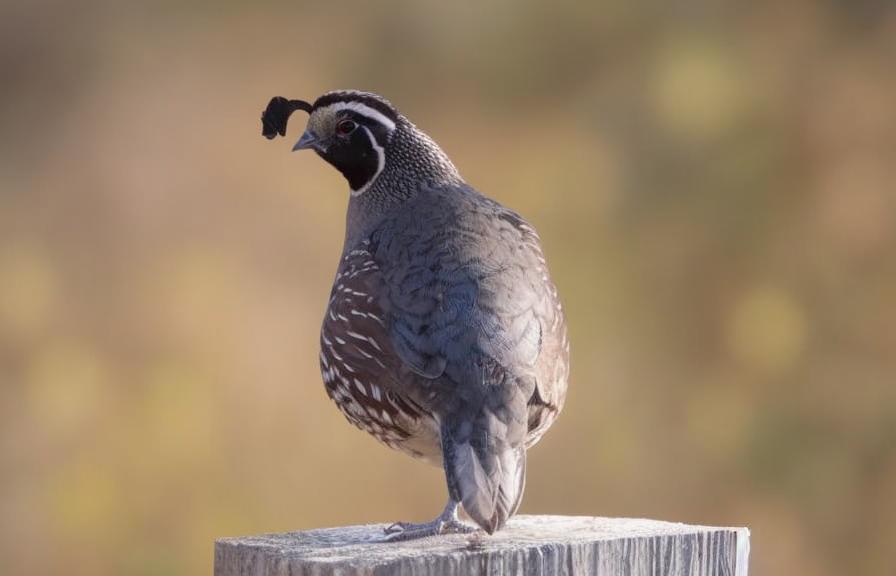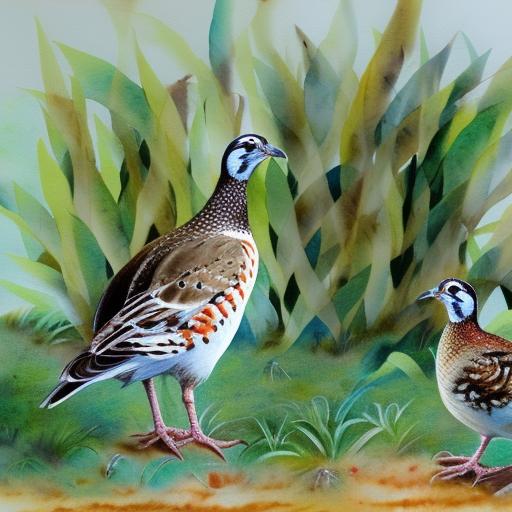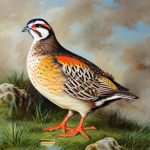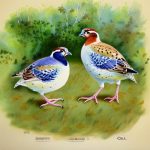Quails are small game birds that are popular for their meat and eggs. There are various breeds of quails, and among them are large quail breeds. Large quail breeds are known for their size and are often preferred for their meat production. These breeds are also popular for their egg-laying capabilities, making them a versatile option for quail enthusiasts. Large quail breeds require specific care and housing due to their size and needs, but they can be a rewarding addition to a farm or homestead. In this article, we will explore the characteristics, popular breeds, housing and care, breeding and raising, and uses of large quail breeds.
Key Takeaways
- Large quail breeds are gaining popularity in the poultry industry due to their size and meat production capabilities.
- Characteristics of large quail breeds include fast growth, high meat-to-bone ratio, and good egg production.
- Popular large quail breeds include the Jumbo Coturnix, Italian, and Tibetan quail, known for their size and meat quality.
- Housing and care for large quail breeds require spacious and well-ventilated coops, proper nutrition, and regular health checks.
- Breeding and raising large quail involves selecting breeding stock, providing optimal conditions for egg laying, and ensuring proper incubation and brooding.
Characteristics of Large Quail Breeds
Large quail breeds are known for their size, with some reaching up to 12 ounces in weight. They have a plump and robust build, making them ideal for meat production. These breeds also tend to have a calm and docile temperament, which can make them easier to handle and manage compared to smaller, more flighty quail breeds. Large quail breeds are also known for their high egg production, making them a popular choice for those interested in both meat and egg production. They are hardy birds that can adapt well to various climates and environments, making them suitable for a wide range of farming operations. Additionally, large quail breeds come in a variety of colors and patterns, adding to their visual appeal for those interested in raising them for ornamental purposes.
Large quail breeds also have specific dietary and housing requirements due to their size. They require a diet high in protein to support their growth and development, as well as access to clean water at all times. When it comes to housing, large quail breeds need ample space to move around and exercise. They also require protection from predators and the elements, so a secure coop or aviary is essential. Providing proper ventilation and bedding is also important for maintaining the health and well-being of large quail breeds. Overall, these birds have unique characteristics that make them a valuable addition to any quail enthusiast’s collection.
Popular Large Quail Breeds
There are several popular large quail breeds that are favored by farmers and homesteaders for their meat and egg production. One of the most well-known large quail breeds is the Jumbo Coturnix Quail. This breed is prized for its large size, rapid growth rate, and high egg production. Jumbo Coturnix Quail come in a variety of colors, including tuxedo, golden, and silver, making them visually appealing as well. Another popular large quail breed is the Italian or Pharaoh Quail. This breed is known for its robust build and excellent meat production. Italian Quail also have a calm temperament, making them easy to handle and manage.
The Tibetan or Tibetan Giant Quail is another popular large quail breed that is favored for its size and meat production. This breed can reach impressive weights and is known for its plump build and flavorful meat. The Tibetan Giant Quail also has a docile nature, making it a great choice for those new to raising quails. Other popular large quail breeds include the Manchurian Golden Quail, British Range Quail, and Roux Dilute Quail. Each of these breeds has its own unique characteristics and qualities that make them valuable additions to any quail enthusiast’s flock.
Housing and Care for Large Quail Breeds
Housing and caring for large quail breeds requires careful consideration of their size and specific needs. When it comes to housing, large quail breeds need ample space to move around and exercise. A spacious coop or aviary with at least 1 square foot of space per bird is recommended to ensure they have enough room to thrive. The housing should also provide protection from predators and the elements, with secure fencing or wire mesh to prevent escapes and keep out potential threats. Proper ventilation is essential to maintain good air quality and prevent respiratory issues, so windows or vents should be included in the design of the housing.
Large quail breeds also require a balanced diet high in protein to support their growth and development. A commercial game bird feed with at least 20% protein is recommended, along with access to clean water at all times. Supplementing their diet with fresh greens, fruits, and vegetables can also provide additional nutrients and enrichment for the birds. Regular cleaning of the coop or aviary is essential to maintain a healthy environment for the birds, as well as providing clean bedding such as straw or wood shavings. Overall, providing proper housing and care for large quail breeds is crucial for their health and well-being.
Breeding and Raising Large Quail
Breeding and raising large quail breeds can be a rewarding endeavor for those interested in expanding their flock or starting a quail breeding operation. When it comes to breeding, large quail breeds reach sexual maturity at around 6-8 weeks of age, at which point they can start laying eggs. To encourage breeding, providing a balanced diet high in protein and ensuring the birds have enough space and privacy in their housing is important. Collecting and incubating the eggs in a specialized quail egg incubator can help increase hatch rates and ensure healthy chicks.
Raising large quail breeds from chicks requires careful attention to their dietary and housing needs. Chicks should be provided with a high-protein starter feed and access to clean water at all times to support their growth and development. They also need a warm and draft-free environment to thrive, with supplemental heat provided through heat lamps or brooder heaters. As they grow, transitioning them to a grower feed with slightly lower protein levels can help support their continued development. Providing proper care and attention during the breeding and raising process is essential for producing healthy and productive large quail breeds.
Uses of Large Quail Breeds

Large quail breeds have various uses that make them valuable additions to any farm or homestead. One of the primary uses of large quail breeds is for meat production. Their size and robust build make them ideal for producing flavorful meat that is prized by many culinary enthusiasts. Large quail breeds are also popular for their egg-laying capabilities, with some breeds laying up to 300 eggs per year. Their eggs are smaller than chicken eggs but are considered a delicacy by many due to their rich flavor and high nutritional value.
In addition to meat and egg production, large quail breeds are also raised for ornamental purposes due to their variety of colors and patterns. They can be kept as pets or showcased in aviaries as part of a decorative display. Large quail breeds are also used for hunting purposes, with some enthusiasts training them as game birds for hunting expeditions. Overall, the uses of large quail breeds are diverse, making them a versatile option for those interested in raising quails for various purposes.
Conclusion and Considerations for Choosing Large Quail Breeds
In conclusion, large quail breeds are prized for their size, meat production, egg-laying capabilities, and ornamental value. When considering which large quail breed to choose, it’s important to take into account factors such as space requirements, dietary needs, climate adaptability, and intended uses. Providing proper housing and care for large quail breeds is essential for their health and well-being, as well as ensuring successful breeding and raising endeavors.
Whether you’re interested in raising large quail breeds for meat production, egg-laying capabilities, ornamental purposes, or hunting expeditions, there are various breeds to choose from that offer unique characteristics and qualities. With careful consideration and attention to their specific needs, large quail breeds can be a valuable addition to any farm or homestead, providing a sustainable source of meat and eggs as well as enjoyment through their ornamental value.
If you’re considering raising large quail breeds, you may also be interested in learning about the best vegetables to feed your quails. Poultry Wizard has a helpful article on what vegetables do quails eat, which provides valuable insights into the dietary needs of quails and how to ensure they receive proper nutrition. Understanding the dietary requirements of your quails is essential for their health and well-being.
FAQs
What are some large quail breeds?
Some large quail breeds include the Jumbo Coturnix Quail, Italian Quail, and Tibetan Quail.
What are the characteristics of large quail breeds?
Large quail breeds are known for their size, which is typically larger than standard quail breeds. They also tend to have a good meat-to-bone ratio, making them popular for meat production.
What are the benefits of raising large quail breeds?
Raising large quail breeds can be beneficial for meat production, as they typically have a higher meat yield compared to smaller quail breeds. They are also popular for their larger eggs, which can be used for consumption or hatching.
What are some considerations for raising large quail breeds?
When raising large quail breeds, it’s important to provide adequate space and housing to accommodate their larger size. Additionally, a balanced diet and proper care are essential for their health and well-being.
Are large quail breeds suitable for beginners?
Large quail breeds can be suitable for beginners, especially those interested in meat or egg production. However, it’s important for beginners to research and understand the specific needs of large quail breeds before starting a new quail farming venture.
Meet Walter, the feathered-friend fanatic of Florida! Nestled in the sunshine state, Walter struts through life with his feathered companions, clucking his way to happiness. With a coop that’s fancier than a five-star hotel, he’s the Don Juan of the chicken world. When he’s not teaching his hens to do the cha-cha, you’ll find him in a heated debate with his prized rooster, Sir Clucks-a-Lot. Walter’s poultry passion is no yolk; he’s the sunny-side-up guy you never knew you needed in your flock of friends!







